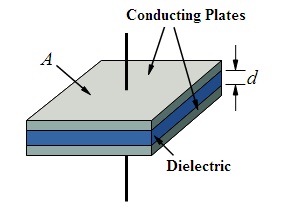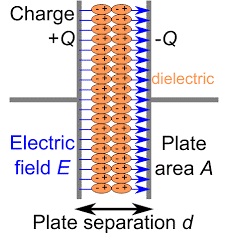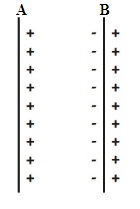In the digital electronic platform, we are so dependent upon mobile applications and devices for entertainment or work purposes. To make it handy, laptops or mobile phones come with rechargeable batteries. These batteries follow the phenomena of charging and discharging. Once charged these become mobile. All the rechargeable circuits possess capacitors in it. These capacitors are filled with various dielectrics results in different types of capacitors. For example paper capacitor, mica capacitor, and so on. Similarly, another type of capacitor called a parallel plate capacitor, it is used for increasing the capacitance. These are the most prominently used energy-storing elements.
What is a Parallel Plate Capacitor?
Definition: An arrangement of two plates can be done in parallel to each other and separated by the dielectric material is known as a parallel plate capacitor. These plates act as electrodes.

Parallel Plate Capacitor
Construction & Principle
The construction of the parallel plate capacitor can be done by following the below steps:
- The plates chosen for the construction of the parallel plate capacitor must be of the same dimensions.
- These plates must be provided with the power supply.
- The plate connected to the positive side of the battery is acquired with positive charges.
- Similarly, the plate connected to the negative terminal of the supply is acquired with negative charges.
- Thus the electric field gets established in between those plates.

Parallel Plates
Principle
The principle of the parallel plate capacitor is

Principle of Parallel Plate Capacitor
- A plate in the capacitor is acquired with a certain value of charges.
- As the charges supplied to the plate increases it leads to the increment in the potential.
- Due to the increase in potential, the charges may undergo leakage.
- S0, to overcome such a situation another plate is placed next to the first plate which is positively charged.
- The next plate placed acquires the negative charges.
- Now both the plates are charged.
- Due to the presence of negative charges on the second plate, it tends to reduce the potential difference on the first plate.
- Similarly, the positive charges present on the other side of the second plate tends to increase the potential difference on the first plate.
- But the effect of potential difference due to negative charges present on the second plate is impactful. So, more amount of charges are given to the first plate.
Hence this is the principle followed in these capacitors.
Parallel Plate Capacitor Derivation & Formula
To understand the capacitance concept for these capacitors let us consider a capacitor with plates marked as M and N. The first plate M carries the positive charge and the second plate N carries the negative charge. The area of the plates is A square meter. The thickness of both the plates must be the same as well as the distance amid the plates is d with certain relative permittivity of the medium εr. The distance between the plates is smaller than the area i.e., d<A.
The first plate is positively charged then the charges in it will be +Q or Q and the area will be ‘A’. Then the density of the surface charges of the first plate is
σ=Q/A
In similar to the first plate the second plate consists of the negative charges denoted by -Q with the area A and its density of the surface charges is
σ=-Q/A
Now we can divide this capacitor into three regions. The first region is the area of the left part of the first plate. The second region is the area between both plates. The third region will be the area of the right part of the second plate.
The electric field magnitude will be the same for the first region but the direction will be opposite for both infinite sheets of the plane.
E= σ/2ε – σ/2ε =0
The electric field’s magnitude and the direction will be the same in the second region.
E = σ/2ε + σ/2ε = σ/ε
The third region resembles the same situation as the first region in which the magnitude of the field will be the same but the direction will be the opposite.
E= σ/2ε – σ/2ε =0
We can conclude that the electric field remains uniform.
Formula
From the above conclusion, we can determine that the direction of this field will be from a positive plate towards the negative plate. The Potential Difference can be calculated by
V = E *d
V= Qd/cA
The capacitance for this capacitor can be derived as
C = Q/V
C= εoA/d
The capacitance regards to the parallel plate capacitors is the limitation that determines how much amount of capacitance can be stored in a capacitor. The type of dielectric chosen also responsible for the capacitance.
Therefore the formula for the capacitance is
C= k εoA/d
Where
k = Relative Permittivity of the dielectrics
εo = Space Permittivity (8.54*10^-12 F/m)
d = distance amid the parallel plates
A = Area of the parallel plates
The Capacitance for a Parallel Plate Capacitors with Two Dielectrics
When the capacitor is filled in such a way that it consists of two dielectrics in it. This situation is referred to as the capacitor has divided into two and are connected in series to each other. Then the only difference in the formula is the distance it must be considered as half for both the capacitors.
let us consider the capacitances as C1 and C2.
C1= k1 εoA/d/2 = 2k1 εoA/d
C2= k2 εoA/d/2 = 2k2εoA/d
The overall capacitance is
1/ Ct = 1/C1+ 1/C2
1/Ct = d/2k1 εoA + d/2k2εoA
Finally, the equation will be
Ct = 2εoAk1k2 / d(k1+k2)
Applications
The applications of parallel plate capacitors are:
- In batteries (Rechargeable Energy System) this type of capacitor is used.
- Dynamic digital memory systems make use of such capacitors.
- Radars and the Pulsed LASER circuits utilize such capacitors.
- In the signal suppression or the coupling of the signals, parallel plate capacitors are installed.
FAQs
1). What is the function of the second plate in a parallel plate capacitor?
The function of the second plate is to increase the capacitance by acting as a conducting neighbor for the first plate.
2). What does the capacitance for a parallel plate capacitor depend on?
The capacitance factor of the parallel plate capacitors depends upon the area of the plates and the distance amid them.
3). What happens when a dielectric is inserted into a capacitor?
The addition of dielectric makes the capacitor to store more amount of charges based on the potential difference applied to it.
4). What happens when a capacitor is disconnected from a battery?
After disconnecting the battery from the charges remains fixed. If there any change in the capacitance it results in the change of the potential difference as well.
Please refer to this link to know more about Parallel plate capacitor MCQs
There is a certain limitation relates to storing the charges. If it exceeds then there is a chance of occurrence of leakage of the charge. To avoid such a situation two plates are used. Hence these parallel plates capacitors are very advantageous when there is a situation to store huge amounts of charges. Further, there are many applications regards to parallel plate capacitors can you describe why the capacitor is used as a coupler?